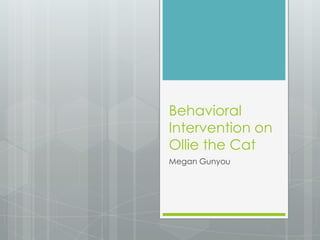
Megan Final Fiesta
- 1. Behavioral Intervention on Ollie the Cat Megan Gunyou
- 2. Ollie Good manners were not in Ollie’s repertoire (set of skills) Mealtime behavior
- 3. Reinforcement Contingency This devious behavior acted as a reinforcement contingency (the response- contingent presentation of a reinforcer resulting in an increased frequency of that response) Before Behavior After No access to food Jumps on table Access to food
- 4. Direct-acting Contingency This contingency maintaining Ollie’s unacceptable table manners is an example of a direct- acting contingency (a contingency in which the outcome of the response reinforces or punishes that response)
- 5. Goal of the Intervention The terminal behavior (behavior not in the repertoire or not occurring at the desired rate) that we were aiming for was to be able to eat dinner and have food on the table without Ollie jumping on the table
- 6. Aversive Condition Aversive Condition (negative reinforcer; any stimulus, event, or condition whose termination immediately following a response increases the frequency of that response) Squirt bottle
- 7. Punishment Contingency Punishment Contingency (positive punishment; response-contingent presentation of an aversive condition resulting in a decreased frequency of that response) Before Behavior After Receives no squirt of aversive water Jumps on table Receives squirt of aversive water
- 8. Results
- 9. Pairing Procedure Pairing Procedure (pairing of a neutral stimulus with a reinforcer or aversive condition) “No!” Squirt of water No “No!” No squirt of water
- 10. New Punishment Contingency Before Behavior After Jumps on table Ollie will not hear “No!” Ollie will hear “No!”
- 11. Avoidance Contingency Avoidance Contingency (response- contingent prevention of an aversive condition resulting in an increased frequency of that response) Before Behavior After Will receive squirt of water soon Will not receive squirt of water soon Jumps down from table
- 12. SD After No treat No treat Treat Not during mealtime During mealtime Sits on floor
